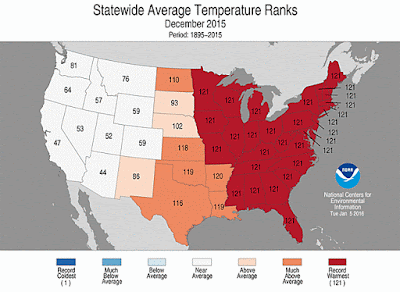Temperature Summary
December temperatures were much above average with some locations reaching the 70s and 80s. Many weather stations observed record-breaking temperatures throughout the month. Virginia, Kentucky, Tennessee, North Carolina, South Carolina, Georgia, Florida, Alabama, and Mississippi experienced their hottest December on record (Fig. 1). Most of the region was 9 to 14 degrees F above their mean temperature norm, while southern Florida was 6 to 9 degrees F above their mean. The warmest part of December was the 24th through the 27th as maximum temperatures reached the 70s and minimum temperatures remained in the 60s. The coolest part of the month was the 19th and 20th as minimum temperatures fell below 30 degrees F over most of the Southeast.
 |
| Figure 1. Statewide average temperature ranks for the month of December. Source: NOAA/NCEI |
Precipitation Summary
Most of the region observed above average precipitation totals by the end of December. In total, eight states (Virginia, Kentucky, North Carolina, South Carolina, Georgia, Alabama, and Arkansas) observed well above average precipitation totals (Fig. 2). Stations in Alabama, Georgia (except the southeastern quadrant), northern South Carolina, North Carolina, south-central Virginia, the Florida Panhandle, and southern Florida recorded precipitation totals 200 to 600 percent of normal. Stations across central and northern Florida and southeastern Georgia recorded precipitation totals 5 to 50 percent of normal.
 |
| Figure 2. Statewide precipitation ranks for the month of December. Source: NOAA/NCEI |
Drought and Climate Impacts on Agriculture
There were no drought conditions (class D1 or greater) present during December.
There were some damaged agriculture reports across the region. Heavy rainfall events caused flooding over southeastern Florida and damaged winter yellow squash, zucchini, and green beans. In Georgia, farmers were unable to harvest a significant amount of their pecan groves due to saturation. Lastly, lack of cold temperatures (specifically between 32 and 45 degrees F) in Georgia reduced the necessary winter dormancy for peach trees and blueberry bushes. This will likely negatively affect the yield in 2016.
In Summary
A couple contributing factors to the abnormal December climate is the El Nino and Arctic Oscillation. El Nino tends to enhance the subtropical jet stream, which directs storm tracks along the southern states. An El Nino normally causes above normal precipitation totals across the southern states during the winter months. In regards to the temperature, the Arctic Oscillation was positive for the majority of December. This means that the Arctic air is trapped in the polar region. Consequently, arctic air masses remained north while southerly flow directed warm air in the region causing above normal temperature conditions.
NOAA National Centers for Environmental Information, State of the Climate: National Overview for December 2015, published online January 2016, retrieved on January 13, 2016 from http://www.ncdc.noaa.gov/sotc/national/201512.

No comments:
Post a Comment